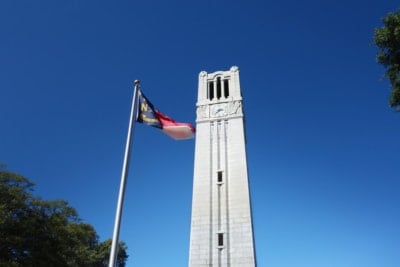When the myFutureNC Commission set out its plan to develop educational attainment goals for all education systems in North Carolina, it made a point of saying the goals must be “evidence-based.” With its strong network of public and private research universities, our state has access to some of the nation’s best evidence on what works to improve student success. The challenge is how to capitalize on this trove of knowledge and share it in order to break down barriers between research, teaching, and public engagement. Here are two brief examples to illustrate what I mean.
Since 1999, scholars at the Center for Child and Family Policy (CCFP) in Duke University’s Sanford School of Public Policy have been studying education policy issues such as achievement gaps, school segregation, and academic redshirting. Many of their studies rely on the N.C. Education Research Data Center. Through a partnership with the N.C. Department of Public Instruction, the data center at CCFP gives scholars access to an immense quantity of longitudinal data on N.C. public schools, students, and teachers.
One such study addresses the optimal time to provide algebra instruction. Knowing – from previous research – that students who complete a math course beyond Algebra II are more than twice as likely to earn a college degree, many schools accelerated the math schedule. Algebra I was often offered to all students in eighth grade rather than ninth, and some could begin as early as seventh grade.
The intentions were good, but what does the research show? In a nutshell, it shows that what is good for higher-achieving students is harmful for lower-achieving students. In some districts, such as in San Francisco, the early Algebra wave has receded — but not without cries of alarm from parents of high achievers. Even when the evidence is clear, structural, practical, and political barriers can hold back progress.
Another example: reading instruction. The National Council on Teacher Quality found that fewer than 4 in 10 teacher preparation programs taught the components of reading instruction that research has shown to be most effective. Slow adoption is part of the problem, and so is active resistance.
These brief stories illustrate the challenges of using evidence effectively. Science is iterative; new studies build on, or call into question, earlier ones. Institutional inertia slows the adoption of best practices. Building consensus takes time and negotiation. The imperative for policy schools such as ours, then, is to develop ongoing dialogues with educators and with policymakers. The myFutureNC Commission recognized the importance of such dialogue when it embarked on a nine-city listening tour across the state, acknowledging that we must work to identify what challenges are faced by individual communities, and what solutions may best fit their unique needs.
The Sanford School has renewed its longstanding commitment to maintaining this critical two-way street. One avenue is the Policy Bridge initiative. We are actively working to share Duke’s scholarly research with policymakers and influencers in a format that is relevant and efficient. At the same time, we want to ensure that the real-world knowledge and needs of these partners informs and strengthens our research.
Do you have ideas on how we can strengthen our connections? I’d like to hear them. Please drop me a line.
Editor’s note: This perspective was originally published by the Hunt Institute. It has been posted with the author’s permission.





